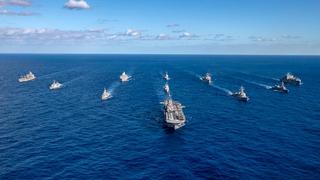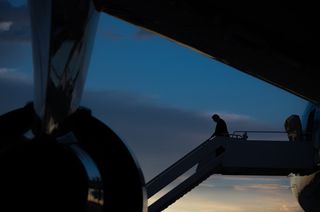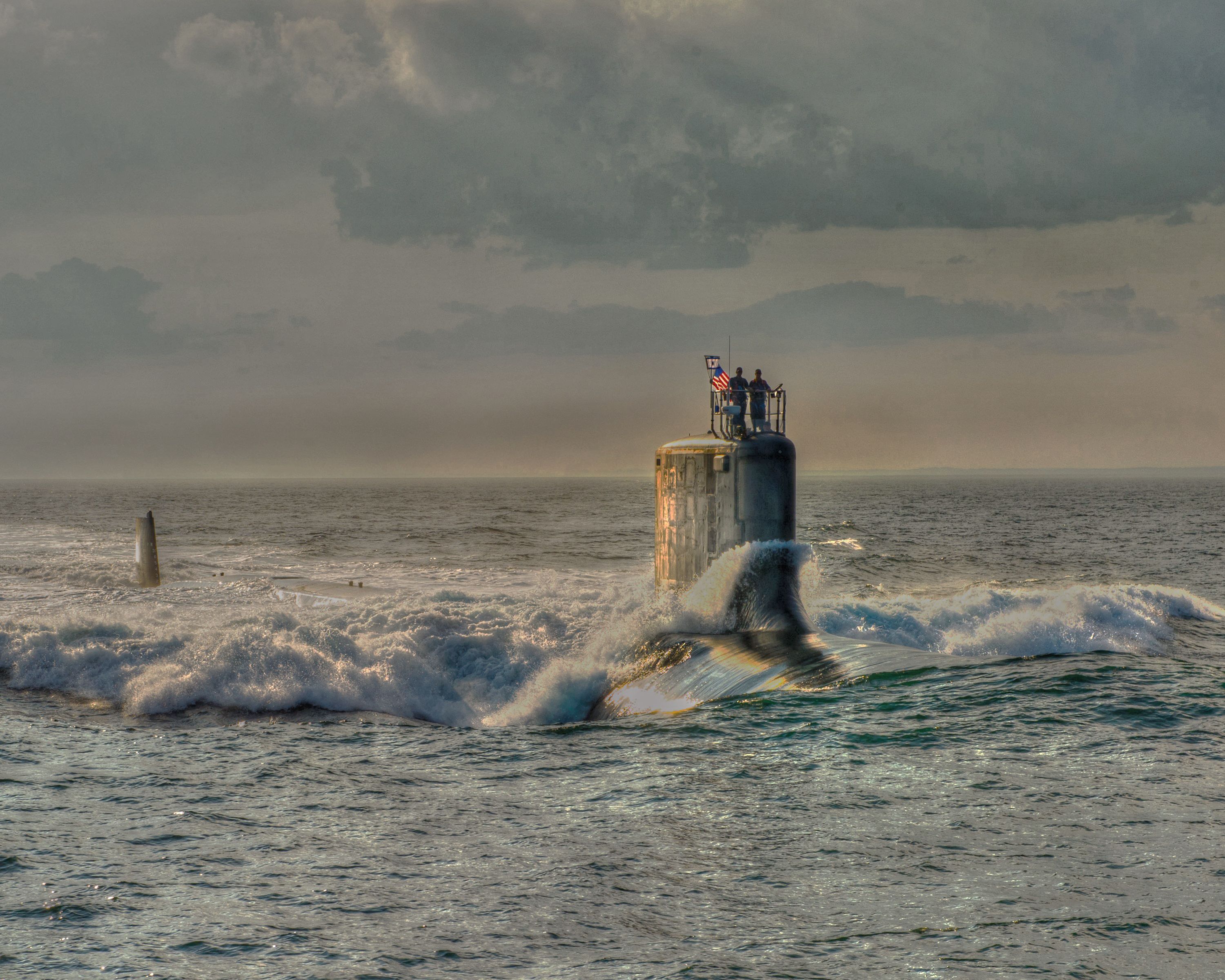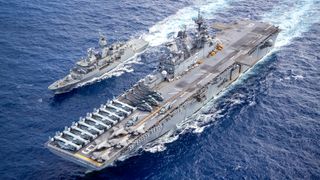Executive summary
- The Biden administration is developing the concept of “integrated deterrence” to advance a networked approach to achieving its defence and security aims across a wide spectrum of strategic competition with China.
- The concept of a network is likely to be persuasive in the Indo-Pacific where not all nations are prepared to choose sides between the United States and China. Although only some allies and partners will seek high-end integration with the United States, fostering military interoperability among the largest possible grouping of like-minded nations remains essential to the success of integrated deterrence.
- Australia is at the forefront of complex, multi-nation military exercises in the Indo-Pacific, and already enjoys a considerable presence inside US Indo-Pacific Command. These factors offer a sound basis for further Australia-US military integration within the Biden administration’s emerging framework of integrated deterrence.
- Australia’s 2020 Defence Strategic Update actually pre-empted the US concept of integrated deterrence by signalling Canberra’s support for a collective deterrence strategy, extending from countering China’s grey-zone coercion to preparing for high-intensity conflict.
- Deepening combined strategic, diplomatic and military planning between the United States and Australia will be critical to the success of a collective deterrence strategy. This should involve allied planning for high-value deterrence scenarios and the expansion of Australia’s access to US forward operating locations in the Indo-Pacific.
Introduction
Australia and the United States have entered a new era of strategic competition with China. Following decades of US military supremacy in the Indo-Pacific, Washington’s approach to regional defence strategy is being re-evaluated in light of a shifting balance of power.1 In Australia, this has sparked debates about the sustainability of the United States’ military position in the Indo-Pacific and what role Canberra should play in collectively upholding the regional order.2 Washington is grappling with these debates, aware that its regional alliance network is a key advantage over its near-peer competitor, the People’s Republic of China.
Australia recognises the challenges to the United States’ ongoing ability to provide a conventional security umbrella for Indo-Pacific nations as well as the opportunities afforded by the US alliance network. It is working to improve its security and regional stability by leveraging the Australia-US alliance and contributing to the development of collective deterrence. The new Australia-United Kingdom-United States trilateral defence technology pact (AUKUS) illustrates this approach. At the launch, the leaders of all three countries emphasised their focus on strengthening the technological foundations of deterrence in the Indo-Pacific, implying, though not directly stating, that preventing Chinese military aggression motivates this arrangement.3 While the initial focus of AUKUS will be the provision of nuclear-powered submarines to Australia, it entails a much broader commitment to empowering Australia through deeper long-term defence materiel and technological integration.4 Coupled with the enhanced Australia-US force posture initiatives announced at the 2021 Australia-US Ministerial Consultations (AUSMIN) — which will include new air, land and maritime rotations, and a combined sustainment facility on Australian soil — this arrangement will accelerate the long-standing bilateral defence integration agenda.5
How the United States views Australia’s future strategic role will strongly influence the success of Canberra’s regional defence strategy. Currently, the Biden administration’s approach to deterrence and the role of US allies and partners reveal two emerging themes. The first is that deep integration between US and allied capabilities creates synergies for high-end war-fighting, bolstering both the perception and material underpinnings of US strategic advantage. This is the hard end of the deterrence spectrum. Indeed, integration is rapidly becoming the byword for the Biden administration’s defence and security aims. Nowhere is this more important than in the Indo-Pacific, where Beijing’s military evolution is on display and relationships with allies and partners are being tested.
At its core, the commitment to share this sensitive defence technology is a powerful show of allied unity and resolve to preserve the regional balance of power.
Integration implies deepening military-to-military arrangements among close allies and select partners through acquisitions, interoperability and joint training adjusted to emerging threat scenarios. The AUKUS nuclear-powered submarine initiative displays a commitment to move forward on all these fronts in an integrated way. Its deterrence effect will be a staggered one, manifest in the announcement itself as well as in the ongoing development and eventual fielding of the submarines. At its core, the commitment to share this sensitive defence technology is a powerful show of allied unity and resolve to preserve the regional balance of power.
The second theme is that the United States intends to work with its allies to build Indo-Pacific collective deterrence more holistically. This sits at the assurance end of the deterrence spectrum. While amorphous as a concept, collective deterrence involves efforts at every level of competition, from emphasising common interests and building partners’ capabilities to resisting coercion and so-called “grey zone” tactics.6 While commonly interpreted as a formal construct by which allies aggregate their capabilities, assets and posture to deter a mutual adversary, collective deterrence can also describe the actions of loose coalitions of partners unbound by treaties or formal arrangements. Such partners may seek to undertake coordinated activities or align statements in order to communicate a consistent deterrence message to common adversaries.7
The relationship between these two themes in the administration’s thinking on integrated deterrence is unclear. Though the path forward on integrated military capability is relatively obvious for Australia and the United States, it is not yet known whether deeper bilateral integration will impact Canberra’s efforts to broaden its pursuit of collective deterrence with other Indo-Pacific nations.8 Addressing this gap will be increasingly important as US plans for the Indo-Pacific evolve. It is possible “integrated deterrence” will become an accelerated manifestation of collective deterrence. Either way, broadening regional commitments to collective deterrence will only be possible if prospective partners believe the United States, Australia and other close allies are capable of delivering — and intend to deliver — regional stability and assurance to those facing Chinese coercion. As such, the role of US allies in the ongoing task of building regional interoperability and operationalising collective deterrence must be made clear and credible.
This policy brief proceeds in four parts. Part one explores what the Biden administration’s new concept of integrated deterrence means for the Indo-Pacific. Part two looks at the evolution and requirements of interoperability among the United States and its regional partners and part three assesses the evolving state of defence integration between the United States and Australia. Finally, the brief concludes with three recommendations for deepening integrated deterrence through the Australia-US alliance.
Updating “integrated deterrence” for the Indo-Pacific
The Biden administration has begun emphasising the term “integrated deterrence” in its defence policy discourse and international engagement. US Defense Secretary Lloyd Austin refers to a “new concept” of integrated deterrence to be designed and carried out “hand in hand with allies and partners.”9 In April 2021, Austin emphasised that effective deterrence today must span multiple domains — air, sea, space and cyberspace — all of which are to be mastered and stovepipes eliminated.10 Nothing short of this, he added, will deliver the “credible, flexible and formidable” deterrence required for a free and open Indo-Pacific.11 Austin repeated this message at the 2021 AUSMIN meeting, but still only at a high level and without additional specifics.12 Likewise, US Under Secretary of Defense for Policy Colin Kahl describes integrated deterrence as bringing together all instruments of US national power — nuclear, conventional, space, cyber and information — and integrating them across all domains from direct conflict to hybrid non-military competition. Washington wants US allies and partners linked up in this way to broaden and deepen deterrence effects.13
The concept of integrated deterrence is not new. Its Cold War meaning, for example, involved calculating the combined effect of nuclear and conventional forces on the Soviet Union’s strategic calculus in the European theatre.14 The concept also includes familiar thinking on deterrence by punishment (imposing unacceptable costs in retaliation to an aggressive action), by denial (preventing an adversary from using aggression to achieve its objectives at acceptable levels of cost and risk), and by entanglement (use of diverse military and non-military instruments to persuade and dissuade, typically through multilateral norm-building).15 The 2018 US National Defense Strategy encompassed these historic definitions of deterrence and sought to develop them into a “seamless integration of multiple elements of national power [and] integrated action with allies” for “proactive and scalable employment of the Joint Force, flexible theatre postures”16 — language that is similar to that now being used by Biden administration officials.

What is new about the way this term is now being used is the focus on enhanced networking with and between allies. Under the Biden administration’s expansive vision for integrated deterrence, allies and partners may contribute to collective deterrence efforts according to their level of willingness and capability — but will nevertheless now be asked to contribute more toward shared security objectives. Those already well integrated may seek to aggregate their defence capabilities with the United States, for example, in logistics arrangements, information sharing or maritime domain awareness. Australia moved decisively in this direction in 2011 when Prime Minister Julia Gillard and President Barack Obama jointly announced Australia would host annual rotations of US Marines in Darwin and enhance air cooperation with the US Air Force in northern Australia.17 The Biden administration’s Deputy Secretary for Defense Kathleen Hicks described this kind of capability aggregation as a “federated” approach to regional security.18
Secretary Austin’s identification of allied networking as the central component of integrated deterrence implies a departure from the hub-and-spoke alliance configuration of the Cold War era. The concept of a network, as opposed to a more hierarchical arrangement among unequal US security partners, may be more persuasive as a model in a region where not all nations are prepared to choose sides between the United States and China. Washington’s message is that members of the network, such as Australia, can demonstrate commitment and capability as a force-multiplier for the United States’ provision of conventional deterrence, shape it and enjoy its protection, without ceding sovereignty.19 But there is a second underlying message. That is, those cynical of US intentions should consider the possibility of a region dominated by a new superpower whose intentions are not transparent, and whose modus operandi increasingly involves military intimidation and economic coercion.
Increasing interoperability among allies and partners
Australia views the challenges emerging in the Indo-Pacific similarly, but not identically, to the United States. Australia does not compete militarily with China in the same manner as the United States. But Australia can shape regional dynamics by virtue of its geopolitical proximity, deep relationships in the neighbourhood and highly advanced military capabilities. As the inaugural 1.5 Track US-Australia Indo-Pacific Deterrence Dialogue identified in 2019, “Australia cannot independently deter Chinese coercion; but it can complicate Beijing’s risk calculus by supporting US deterrence efforts, building resilience, and fostering collective action in the Pacific and Southeast Asia.”20
In support of those efforts, Australia has long participated in building conventional interoperability with the militaries of this region. This is demonstrated by its commitment to US-led regional military exercises and its inclusion of regional participants in Australian-led exercises like TALISMAN SABRE, INDO-PACIFIC ENDEAVOUR and PITCH BLACK.21 Scenarios to address non-traditional security threats increasingly feature in these exercises and related regional assistance programs. This demonstrates Australia’s responsiveness to key concerns of vulnerable nations, including the destabilising effects of illegal activities, over-fishing, cyber intrusion and climate-related disasters.22 Addressing these non-traditional threats is a way of augmenting hub-and-spoke alliance structures to network with new partners. Indeed, regional militaries have played key roles in exercising humanitarian assistance and disaster response scenarios, providing operational lift for civilian assistance to disaster zones spanning multiple national jurisdictions.23
Yet, even among close allies, multilateralising military exercises and operations can be difficult. Building interoperability is a slow and complex task dependent on participating nations’ political buy-in, as well as their capacity and willingness to work within practical constraints such as incompatible military hardware and software. Perhaps unsurprisingly, there are few examples of significant military interoperability between Indo-Pacific nations in the absence of US involvement, with the prominent exception of Australia and Japan. With that said, regional militaries are increasingly sharing assessments, exercising together, and identifying barriers to deeper technology, communications and operational cooperation.
The value of interoperability
The Biden administration’s multifaceted approach to integrated deterrence demands a range of approaches to give it practical effect. First, building interoperability with a wide range of partners is crucial. The compelling benefits of interoperability may serve to influence attitudes among regional militaries, building awareness of the imperative for collective deterrence among senior military officials. Second, undertaking multilateral military conferences and exchanges is important to develop mutual understanding and can enable the delivery of collective messages that reinforce consistency of purpose. Third, opportunistic, loosely coordinated, high-end activities among capable nations are needed to signal credibility and resolve to adversaries and other nations. Finally, mounting complex, multi-flag exercises around real-world scenarios with the most advanced military assets of close allies remains a powerful display of deep interoperability and the capacity for integrated deterrence.
Mounting complex, multi-flag exercises around real-world scenarios with the most advanced military assets of close allies remains a powerful display of deep interoperability and the capacity for integrated deterrence.
Several examples illustrate these ongoing efforts to build interoperability and integration in the Indo-Pacific.
In Honolulu, INDOPACOM and its component commands — US Pacific Fleet (PACFLT), US Army Pacific (USARPAC), US Marine Corps Forces Pacific (MARFORPAC) and US Pacific Air Force (PACAF) — use their convening power to engage counterparts on regional threats and potential barriers to achieving interoperability.24 Among the militaries, it is not uncommon for differing interpretations, capability gaps and institutional or political preferences to arise in ways that are at odds with US preferences. Nonetheless, counterpart commanders often have common service-specific language, traditions and outlooks that can bridge these gaps. Their own training involves exchanges and programs in the United States, Australia and other western-aligned nations. These experiences can smooth the way for relatively seamless involvement in US-led exercises and training on US-origin hardware. Such regular interaction over decades can deepen regional commitment to achieving interoperability even if substantial quantities of Russian and Chinese-origin military equipment remain in use by many partners.25
More pointedly, like-minded nations have sought to signal deterrence in the region through parallel or loosely coordinated military activity. For instance, South China Sea transits by warships from Australia, the United States, the United Kingdom, Canada, New Zealand, Germany, France, the Netherlands and India occurred in close succession during July and August 2021,26 signalling their shared commitment to maintaining a “free and open Indo-Pacific.”27
Premier examples of integrated deterrence in a war-fighting context are on display at the biennial Australia-US exercise TALISMAN SABRE. It is one of the region’s key high-end military exercises, in which an increasing number of allies participate.28 This year, the Republic of Korea joined TALISMAN SABRE 2021 for the first time, which featured live-fire activities, amphibious beach landings, cyber and space components and other complex war operations. Personnel from four of the five participating nations — Australia, the United States, Japan and the United Kingdom — operated from the same ship as an integrated landing force for the first time.29 Crucially, TALISMAN SABRE elicits few regional criticisms and has projected benign intent to non-adversaries while signalling commitment and capability to jointly deter adversaries.
Integrated deterrence and the US-Australia alliance
Australia is very well placed to contribute to the Biden administration’s development of integrated deterrence. Canberra’s July 2020 Defence Strategic Update (DSU) outlined major investments in defence self-reliance and a reinvigorated focus on strategic dynamics in Australia’s immediate neighbourhood, ranging from the north-eastern Indian Ocean through maritime and mainland Southeast Asia to Papua New Guinea and the South West Pacific.30 Defence Minister Peter Dutton emphasised the mutually reinforcing aims of the DSU — self-reliance, supply chain resilience and interoperability with allies and regional partners — in a September 2021 speech just prior to AUSMIN 2021, focusing on new Australian capabilities in space, cyber, artificial intelligence and hypersonics.31
According to these declarations, self-reliance and deeper integration with the United States are not perceived by Canberra as mutually exclusive, nor is integration with the United States incompatible with ongoing efforts to broaden collective deterrence in the Indo-Pacific. On the contrary, by integrating deeply with the United States, Australia aims to simultaneously enhance self-defence, deter military and non-military coercion, and contribute to greater regional interoperability and commitment to collective deterrence.
This ambitious and inclusive approach to regional defence strategy complements the United States’ nascent efforts to integrate key allies into networked security arrangements. Indeed, the overarching message in Australia’s announcements was that it would seek to be more self-sufficient, more present across its northern littoral, and more integrated with the United States and close security partners across a spectrum of competition from grey-zone coercion to high-intensity combat. Australia’s language preceded and closely mirrors the style of integrated deterrence now being promoted by the Biden administration. Even in the absence of a shared strategic concept, this implies a convergence of views between Washington and Canberra on the need to collectively address wide-spectrum deterrence challenges in the Indo-Pacific.

A sound basis for integration
Significant integration between Australia and the United States is already happening among personnel from both countries within the US combatant commands. Today, some 45 Australian defence personnel work inside INDOPACOM or are embedded in its component commands. A two-star Australian Army Major General occupies the position of Deputy Commander (North) in USARPAC, a two-star Royal Australian Navy Rear Admiral will join PACFLT in 2022, one-stars work as deputies embedded into the INDOPACOM Joint Offices for Policy and Planning and Intelligence, and others are spread across the service commands. While forces from other allied nations are also placed within the US commands in Hawaii, Australia enjoys outsized representation.32 This level of integration is a testament to the United States’ willingness to work seamlessly with Australia in its largest and oldest command.
INDOPACOM is a steward of this process. Its commanders consistently welcome and invite integration with Australia, pay close attention to the diplomatic envelope surrounding military operations and seek to entrench the cultural and practical issues required for joint planning. They are committed to implementing the DIME — diplomatic, information, military and economic — effects across US agencies and in concert with Australia, Japan, the Republic of Korea and other allies.33 Although US settings on information sharing remain siloed and strict for close allies like Australia, there is an ongoing push to increase the scope and efficiency of default information sharing within the alliance through the Australia-US bilateral Security of Information Agreement — which would enhance both nations’ ability to devise deterrence effects and regional engagements in real-time and over the longer term.34
From interoperability to integrated deterrence
Even so, building the combined capabilities of a network of allies and partners to underwrite integrated deterrence in the region will be a complex, long-term project. Among Indo-Pacific allies, Australia and the United States are at the forefront of moving decisively down this path. Crucially, the 2021 AUSMIN communiqué detailed joint force posture plans enabling deeper integration across air, sea and land domains, all of which will take place on Australian territory. This will include rotational deployment of all types of US aircraft in Australia; increased logistics and sustainment capabilities of US surface and subsurface vessels in Australia; and more complex and integrated land exercises with greater combined engagement with regional allies and partners — in short, a greater number of US military assets operating with Australian forces, from Australian locations and supported by new bilateral military facilities.35 This last item will impact greatly on Australia’s interlocking aims for self-defence, deterring military and non-military coercion and simultaneously forging a regional commitment to collective deterrence.
A host of major interoperability training and military exercises in the Indo-Pacific have long supported this alliance integration agenda. These include TALISMAN SABRE, INDO-PACIFIC ENDEAVOUR, PITCH BLACK, INDOPACOM’s PACIFIC PATHWAYS, and multilateral exercises such as the US-led Rim of the Pacific (RIMPAC) and COBRA GOLD hosted by Thailand.36 Exercise MALABAR, now involving all four Quad partners — Australia, India, Japan and the United States — is the most recent addition to the regional calendar.37 All provide important opportunities for achieving closer interoperability among a broad array of participants.
Going forward, the challenge is to design and conduct these exercises in ways that reinforce the benefits to be had from operating with the United States while advancing participants’ shared interests in defending a free and open Indo-Pacific. Once regional militaries can put the COVID-19 pandemic behind them and return to regular training initiatives with Australia, the United States, Japan and others, the benefits of this accelerating agenda should become clearer. It is difficult to assess whether momentum has been lost after exercises such as RIMPAC and COBRA GOLD were scaled down due to restrictions on in-person activities during the COVID-19 pandemic.38 Critical to their success, and to broadening the awareness of the imperative for collective deterrence, are the personal interactions among troops, commanders and policy advisers exercising together under common command-and-control. While this process advances slowly with the Indo-Pacific’s more hesitant partners, Australia, the United States and highly capable partners like Japan must move ahead with deeper integration — continuously sharing and honing threat assessments, reducing barriers to information sharing, testing the congruence of doctrines and postures and planning joint operations.

Policy recommendations
The following lines of effort between Australia and the United States could advance bilateral defence integration in ways that demonstrate to regional partners the practical benefits of collective deterrence.
- Explore options for combined strategic, diplomatic and military planning centred around high-value deterrence scenarios.39
The US military should further involve and collaborate with Australia at earlier stages of US planning processes, as described in the 2018 US National Defense Strategy and indicated in the 2021 Interim National Security Guidance.40 Beginning with contingency planning for Pacific and Southeast Asian scenarios that include grey-zone tactics or the limited use of force by China, Canberra and Washington could consider combined command structures for maritime intelligence surveillance and reconnaissance (ISR) and anti-submarine warfare (ASW) patrols between the Cocos Islands, Northern Australia and Guam. They may also consider expanding these joint efforts to include India and Japan with access to the Andaman and Nicobar Islands and the Japanese archipelago.41 - Explore new force posture initiatives in Australia’s immediate region, including expanded provision for the ADF to access US forward operating locations.42
Greater Australian access to US operating locations in Guam, the Philippines and Singapore could significantly augment the ADF’s strategic footprint. This is congruent with the DSU’s call for an ADF capable of mounting independent deterrence effects in Australia’s immediate region, countering grey-zone coercion and leading coalition operations. Pursuing combined access arrangements would also create opportunities for new exercises and peacetime deterrence operations, including efforts to pool allied military assets and integrate crews and personnel. - Expand and improve allied coordination in support of third parties through increased maritime presence operations.
Canberra and Washington should progress from exercising opportunistic presence as a show of support to third parties in contested regional waters to more explicitly plan for and coordinate the transit of warships for a general deterrence effect. The US Coast Guard and Australian Border Force should be brought to a joint planning table to identify ideal modes for combined maritime presence operations. Both countries should capitalise on London’s decision to deploy a carrier strike group for a seven-month mission to the Indo-Pacific to plan future expanded deterrence activities together in the Indian and Pacific Oceans.43
Conclusion
The Indo-Pacific is rapidly emerging as the primary theatre for strategic competition between the United States and China. Sophisticated forms of military and non-military coercion are driving efforts by the United States and its allies to develop deterrence options across a wide spectrum of operations. Australia’s commitment to self-reliance in deterrence capability, its close alliance relationship with the United States, and its sharper focus on its immediate neighbourhood provide a solid foundation for closer Australian involvement in the operationalisation of the Biden administration’s “integrated deterrence” concept. The challenge now is to do so in a way that bolsters, rather than undermines, efforts to reassure non-aligned regional nations that the US-led alliance network will continue to underwrite peace and prosperity in the Indo-Pacific.
This activity was supported by the Australian Government through a grant by the Australian Department of Defence. The views expressed herein are those of the author and are not necessarily those of the Australian Government or the Australian Department of Defence.




.jpg?rect=0,80,3000,1989&fp-x=0.5&fp-y=0.44772296905517583&w=320&h=212&fit=crop&crop=focalpoint&auto=format)

